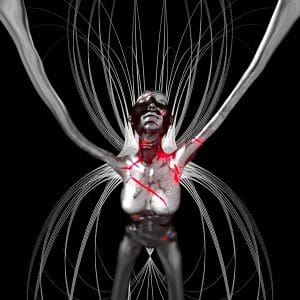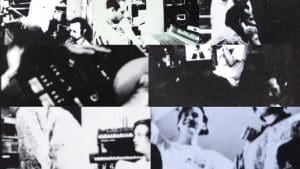‘Click Interview’ with Synta[XE]rror: “We Do Not Create Music For A Specific Recipient”
![click Interview with Syntaxerror we Do Not Create Music for a Specific Recipient Sideline Magazine 'click Interview' with Synta[xe]rror: "we Do Not Create Music for a Specific Recipient"](https://www.side-line.com/wp-content/uploads/2021/07/Syntax-Error-1024x768.jpg)
![click Interview with Syntaxerror we Do Not Create Music for a Specific Recipient Sideline Magazine 'click Interview' with Synta[xe]rror: "we Do Not Create Music for a Specific Recipient"](https://www.side-line.com/wp-content/plugins/wp-fastest-cache-premium/pro/images/blank.gif)
Synta[XE]rror is a Polish project driven by Artur ‘Blacha’ Błaszczyk and Bartosz ‘Kostia’ Jakubicki. The name of the project was influenced by the ‘error’ message they saw most often on their Amigas. The name evolved into ‘syntax error’, but as there were several bands with the same name, the duo decided to put square brackets around the XE. Synta[XE]rror released two albums (cf. Abyad” in 2006 and “Final” in 2007) and this year strikes back after a serious hiatus of time with their third full length opus “[.]Dot”. The work has been released on the excellent Polish label Zoharum and reveals a sophisticated Electronic sound, which sounds as a mix between IDM, Minimal-Electro and Experimental music. I asked a few questions to ‘Blacha’.
(Courtesy by Inferno Sound Diaries)
Q: How would you introduce and describe the sound of Synta[XE]rror to all those who don’t know you yet?
Blacha: If you are interested in an unconventional approach to music, you like broken rhythms or non-obvious melodies, you are a fan of sci/fi cinema, cyberpunk literature, our sounds may interest you.
Q: “[.]Dot” is your first new album since 2007. What have you been doing in the meantime and what have been the triggers and influences to compose new work?
Blacha: “[.] Dot” was written in 2008-2009, but unfortunately we did not manage to release it at that time. We got back to this material last year, it was reconstructed and improved a bit and it appeared in this light this year. It is a bit of a search for rhythm, a response to the IDM that I started to listen to at that time and a desire to create something more optimistic than the previous album “Final”. I believe that it is a stylistically coherent material, creating a homogeneous whole. It was a game of rhythmic and sound structures that interpenetrate and complement each other, but none of them dominant.
Q: What’s your way of working together and what’s the input of each member? What have been the different stages you’d to go through to achieve “[.]Dot” ?
Blacha: Currently, we mainly work separately. Basically, 90% of the audio material is my responsibility, Kostia is a critic who listens to ideas of tracks and evaluates them, suggesting what sounds trivial and should be changed. Sometimes he remakes tracks a bit, but recently he focused on the visual side of the band, he creates animations, which he mixes during concerts, creating visualizations for our music.
Q: What have been the main difficulties, eventually challenges and satisfactions about “[.]Dot”?
Blacha: The biggest difficulty in creating material for “[.] Dot” was breaking out of the pattern that followed on the previous album and, above all, infusing the music with more positive feelings/energy. Resignation from a large number of samples, an attempt at such a minimalist approach to creating sounds. It didn’t quite work out, because the songs on “[.]Dot” are multi-layered, which is not a mistake in the end :). What we managed to do was to create a coherent album, we planned 9 songs from the beginning, because the album cover was created parallel to the music layer, and despite the consistency, the songs are still diverse. It is not dance music :), but still rhythmic and, in my opinion, not boring 🙂 But rather, the audience should judge this 🙂
Q: Tell us a bit more about the clip you made for “Melting Point” and what did you try to express?
Blacha: The clip for “Melting Point” has no hidden overtones. It corresponds to the digital nature of music. This video puts on many layers, each of which lives a separate life, and yet interacts with each other -it’s a phenomenon of synergy. They correlate with rhythm, changes in sounds, and human channels of perception. Video focuses attention on the structure of the image, not a story, and serves as a background for music reception.
Q: “[.]Dot” is an intelligent and sophisticated electronic production. Unfortunately, it seems there’s only a very restricted number of people who like this kind of music. How does that feel for you as musicians? And what do you think about specific genres like Industrial, IDM, EBM, Ambient-Electro etc?
Blacha: We are pleased with every listener, but I must admit that we do not create music for a specific recipient, because we do not clearly define ourselves as to the style of music. What we do is widely understood Electronics, which is the result of the music we listen to. The spectrum is wide from Classical music, through traditional Electronics, IDM, Noise, Industrial, EBM and Ethnic music. To sum up, making music is a stepping stone from everyday life for us, realizing ourselves on a different level of feeling, a different form of creation. It is important for us to share what we create with the audience, but it is not a form of exhibitionism, but a willingness to share those feelings that are understandable to people with similar sensitivity or fascinated by a similar style.
I don’t want to talk about genres of music, in recent times they have become more and more diverse and at the same time the boundaries between the styles are starting to blur, I just listen to what I like at the moment corresponds to my mood, I am open to any imaginative sounds.
Since you’re here …
… we have a small favour to ask. More people are reading Side-Line Magazine than ever but advertising revenues across the media are falling fast. Unlike many news organisations, we haven’t put up a paywall – we want to keep our journalism as open as we can - and we refuse to add annoying advertising. So you can see why we need to ask for your help.
Side-Line’s independent journalism takes a lot of time, money and hard work to produce. But we do it because we want to push the artists we like and who are equally fighting to survive.
If everyone who reads our reporting, who likes it, helps fund it, our future would be much more secure. For as little as 5 US$, you can support Side-Line Magazine – and it only takes a minute. Thank you.
The donations are safely powered by Paypal.
![click Interview with Syntaxerror we Do Not Create Music for a Specific Recipient Sideline Magazine 'click Interview' with Synta[xe]rror: "we Do Not Create Music for a Specific Recipient"](https://www.side-line.com/wp-content/uploads/2022/03/cropped-cropped-sl-logo-png.png)
![click Interview with Syntaxerror we Do Not Create Music for a Specific Recipient Sideline Magazine 'click Interview' with Synta[xe]rror: "we Do Not Create Music for a Specific Recipient"](https://www.side-line.com/wp-content/uploads/2023/09/cropped-image0-2.jpeg)
![click Interview with Syntaxerror we Do Not Create Music for a Specific Recipient Sideline Magazine 'click Interview' with Synta[xe]rror: "we Do Not Create Music for a Specific Recipient"](https://www.side-line.com/wp-content/uploads/2023/02/Synta-XE-rror.jpg)
![click Interview with Syntaxerror we Do Not Create Music for a Specific Recipient Sideline Magazine 'click Interview' with Synta[xe]rror: "we Do Not Create Music for a Specific Recipient"](https://www.side-line.com/wp-content/uploads/2023/01/electronic-bodies-scaled.jpeg)
![click Interview with Syntaxerror we Do Not Create Music for a Specific Recipient Sideline Magazine 'click Interview' with Synta[xe]rror: "we Do Not Create Music for a Specific Recipient"](https://www.side-line.com/wp-content/uploads/2022/04/wgt2022.jpg)
![click Interview with Syntaxerror we Do Not Create Music for a Specific Recipient Sideline Magazine 'click Interview' with Synta[xe]rror: "we Do Not Create Music for a Specific Recipient"](https://www.side-line.com/wp-content/uploads/2022/02/INDUSTRIAL-BEATS-2900X2900.jpg)





